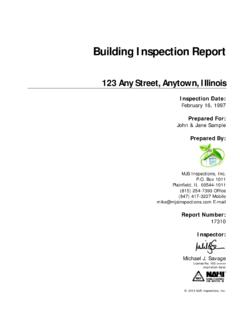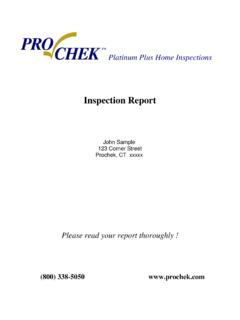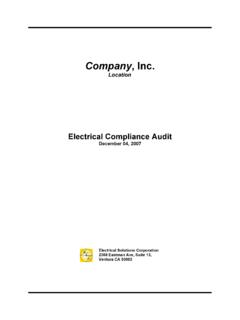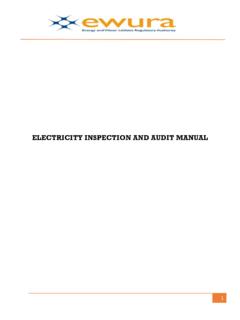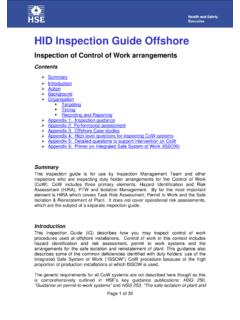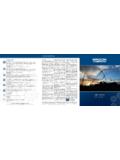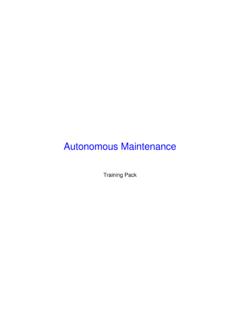Transcription of ED Offshore Inspection Guide - Health and Safety …
1 Page 1 of 8 TRIM Ref: 2017/368100 ED Offshore Inspection Guide Inspection of Well Control Contents Summary Introduction Action Background Recording and Reporting Appendix 1: Inspection guidance Appendix 2: Performance assessment Summary This Inspection Guide is for use by Energy Division (ED) Inspection Management Team inspectors and other ED non-wells specialist inspectors who are undertaking a basic Inspection of arrangements for Well Control during drilling, testing, completion and other well intervention or maintenance/repair (work over) operations.
2 It provides questions to ask key personnel involved with such operations. These questions are designed to sample key components that provide for effective well control. It provides a basis for both assessing compliance with the relevant statutory provisions and for assessing and scoring operator performance in line with HID s Targeting and Prioritisation policy for Offshore Installations (ref. 1). Introduction DCR (ref. 2) Regulation 13 requires the well-operator to ensure that a well is so designed, modified, commissioned, constructed, equipped, operated, maintained, suspended and abandoned that, so far as is reasonably practicable, there can be no unplanned escape of fluids from the well.
3 HSE guidance to the wells aspects of DCR (ref. 2) is available (ref. 3). A separate Inspection Guide covers Inspection of Wells Personnel Competency (ref. 4). Page 2 of 8 TRIM Ref: 2017/368100 This Inspection Guide covers well control during well construction and maintenance including drilling, testing, completion and other well intervention or maintenance/repair (work over) operations, including final decommissioning where the drilling blowout preventers (BOP) are in use.
4 It does not include drilling or well intervention activities where wire-line, coiled tubing, managed pressure drilling or under-balanced drilling pressure control equipment is in use. It does not cover all aspects of these operations for which industry good practice guidance is available (ref. 5). Rather it provides questions to ask key personnel so that key components that provide for effective Well Control can be sampled. The large topic of well control has for this purpose been broken down into sub-topics with sample questions for each: a) well control procedures b) well control equipment c) well control training d) well control drills e) communications Model answers are provided for each question so that the extent of compliance can be gauged.
5 Action The need for inspections of well control arrangements for particular installations will be identified in the operator Proposed Intervention Priorities. Specific Well Control inspections will be scheduled in the annual installation Intervention Plan. Where a Well Control Inspection is called for in the Intervention Plan a basic well control Inspection may be carried out by the IMT or other non-wells specialist in accordance with this Inspection Guide . See Appendix 1 for questions to be asked during such an Inspection .
6 A more detailed Well Control Inspection may be carried out by a Well Operations specialist subject to availability. Where significant concerns are identified by an IMT or non-wells specialist a Well Operations specialist should be consulted at the earliest opportunity and appropriate action decided. Recording & Reporting The duty holder performance ratings in accordance with Appendix 2 should be entered on the Inspection Rating Form (IRF) tab of the relevant installation COIN Intervention Plan Service Order.
7 Findings should be recorded in the normal post Inspection report(s) and letter. Page 3 of 8 TRIM Ref: 2017/368100 Further References 1. HID Targeting & Prioritisation Arrangements for Prioritising Major Hazard Inspections of Offshore Installations 2. Offshore Installations and Wells (Design, construction, etc) Regulations 1996 3. A Guide to the well aspects of the Offshore Installations and Wells (Design, Construction, etc) Regulations 1996, L84, HSE 4. HID Offshore Inspection Guide Wells personnel competency management system Inspection Guide 5.
8 Well Life Cycle Integrity Guidelines, Issue 3 , March 2016, Oil and Gas UK 6. Guidelines on BOP Systems for Offshore Wells, Issue 2. May 2014, Oil and Gas UK Contacts ED Offshore : ED 6 Well engineering & operations inspectors Page 4 of 8 TRIM Ref: 2017/368100 Appendix 1 Inspection Guidance 1. Well Control procedures Questions for the Driller: a) Are there any standing instructions for the driller on well shut in? There should be some standing instructions on how the well will be shut in. This will be by the relevant method (hard, soft or fast method) of securing the well.
9 Relevant BOP/Well control equipment schematics to support standing instruction (shut in sequence) for particular well work being undertaken. Awareness of Shear ram capability and sequence planned for particular project. b) Is there a recent well control sheet on the rig floor which is completed as much as possible? This is a sheet that will be completed with actual bit depth, mud density etc. at the time of a kick. However data that will not change like the water depth, depth of last casing shoe, slow circulating rates should be on this sheet so that arriving at the kill calculations is as efficient as possible.
10 (Note - Slow circ rates change regularly dependent on well depth, hole / drill string configuration and mud rheology. When drilling these should be re-checked and recorded regularly every 1000ft / 12 hours etc) and on any occasion there is a significant change in mud weight. Questions for rig crew member(s): c) Are well control procedures discussed with the drill crew? What is your role? The drill crew need to be aware of their role in shutting in the well for the operations going on at the time.











